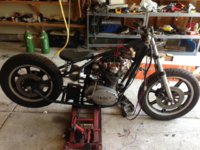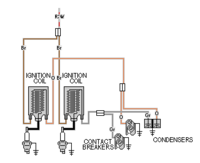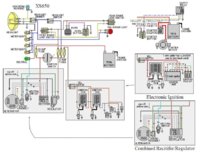I have rewired a few in my day. It's not near as hard as you think it will be.
The best place to start is the charging system. Get that wired right and the rest is easy.
Here is a diagram that shows the basic points, with the seperate reg and rec. It has the TCI in a box, it has the later combo reg/rec in a box.
Start by looking at the charging system. On the points, hooking the stator to the rectifier is pretty straightforward. The three white wires to the three white wires. Red to battery. The Black to ground.
The brushes hook up just as easy. The green wire to the regulator, black wire to ground.
The brown wire on the reg hooks to power after the main switch. Once you get these all wired up. Hooking the ignition is easy too. Run w ire from the battery to a 20 amp fuse, from the fuse to the main switch. From the main switch power goes out on the brown wire. Hook all you fuses to this brown wire. Each fuse runs a seperate circuit. use a ten amp fuse and run a wire to a kill switch, from the kill switch to the ignition. On points , the coil. On a TCI the coil and the TCI box.
Once you get the ignition wired it should start. Use the kick start till you get the e-start wired.
Once you get it running check the charging system for proper function.
Once you get it to run and charge you can hook another fuse to the brown wire and run power to the lights. I would use an on/off switch , from the on/off switch to the dimmer switch and the tail light. From the dimmer to the headlight.
Make sure you have good grounds on the lights.
You can add brake light switches easy too. A fuse, or hook to your lighting fuse. Run power to the switches. From the switches to the brake light.
Once you get that far adding any other lighting you want is just as easy. Add a fuse, run some wire, switches, good grounds.
One thing yoiu might want is to have the horn. Run it the same way, power to a fuse, to the horn then to a button, from the button to ground.
This should get you started. Just remember that the word circuit comes from the same root word as circle. Power has to travel in a circle. Starts at the battery, goes out to a control, to a load, from the load back to the battery.
Leo






